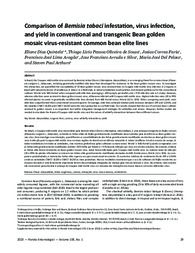Comparison of Bemisia tabaci infestation, virus infection, and yield in conventional and transgenic Bean golden mosaic virus-resistant common bean elite lines.
Comparison of Bemisia tabaci infestation, virus infection, and yield in conventional and transgenic Bean golden mosaic virus-resistant common bean elite lines.
Author(s): QUINTELA, E. D.; SOUZA, T. L. P. O. de; FARIA, J. C. de; ARAGÃO, F. J. L.; SILVA, J. F. A. e; DEL PELOSO, M. J.; ARTHURS, S. P.
Summary: In Brazil, the Cowpea mild mottle virus vectored by Bemisia tabaci (Genn.) (Hemiptera: Aleyrodidae), is an emerging threat for common bean (Phaseolus vulgaris L.; Fabaceae), including genetically modified elite bean lines developed for resistance to the Bean golden mosaic virus. To investigate this interaction, we quantified the susceptibility of 10 Bean golden mosaic virus-resistant lines to Cowpea mild mottle virus infection in 2 regions in Brazil with natural incidence of viruliferous B. tabaci. In 2 field trials, B. tabaci established on all varieties, but showed preference for the conventional cultivars ?Pérola? and ?BRS Pontal? when compared with elite lines (averaging > 400 nymphs per leaflet, and > 97% infection rate in 1 study). However, whereas elite lines were resistant to Bean golden mosaic virus, all became infected with Cowpea mild mottle virus. Highest infection rates (19 to 99% infected plants) occurred in genetically modified elite lines derived from BRS Pontal versus Pérola (12 to 16%). When comparing seed yield, most elite lines outperformed their conventional recurrent parent. On average, elite lines achieved relative yield increases between 199 and 1,045%, and the varieties CNFCT 16205 and CNFCT 16210 were the most productive in our field trials. Our results showed that the use of common bean cultivars resistant to golden mosaic is an important tool within integrated management strategies for whiteflies and viruses. However, further studies are needed to elucidate the threat of Cowpea mild mottle virus and the nature of whitefly interactions between these different viruses.
Publication year: 2023
Types of publication: Journal article
Unit: Embrapa Rice & Beans
Observation
Some of Embrapa's publications are published as ePub files. To read them, use or download one of the following free software options to your computer or mobile device. Android: Google Play Books; IOS: iBooks; Windows and Linux: Calibre.
Access other publications
Access the Agricultural Research Database (BDPA) to consult Embrapa's full library collection and records.
Visit Embrapa Bookstore to purchase books and other publications sold by Embrapa.

